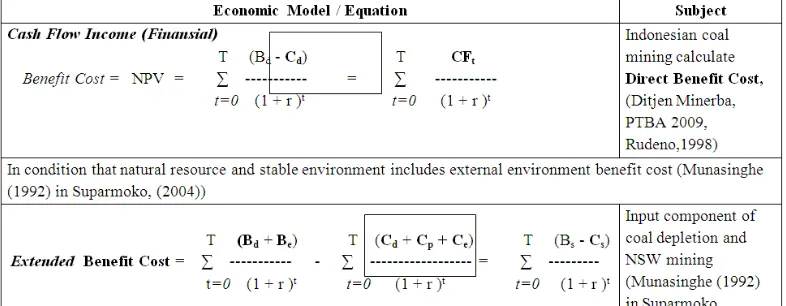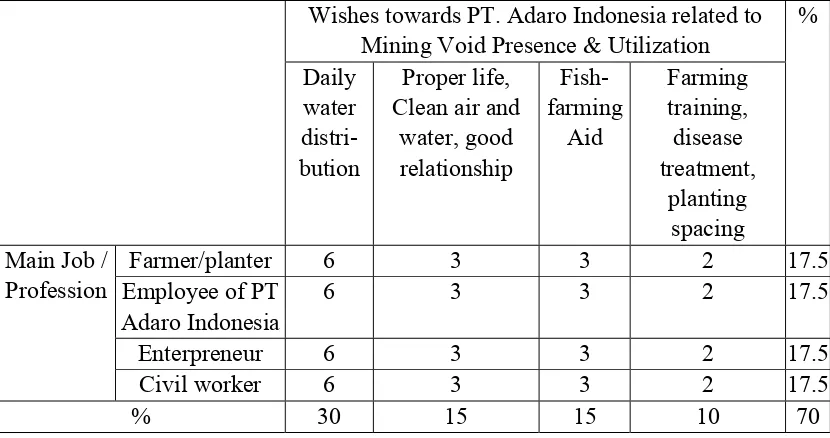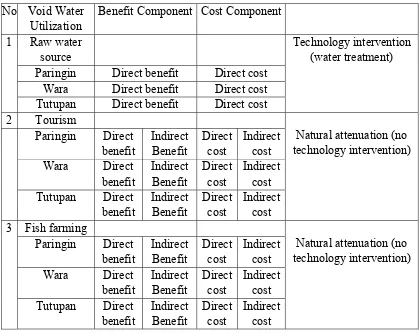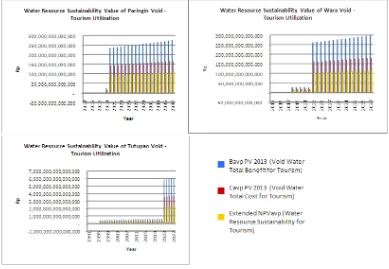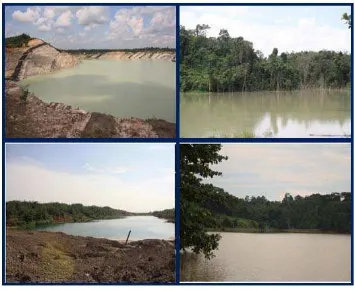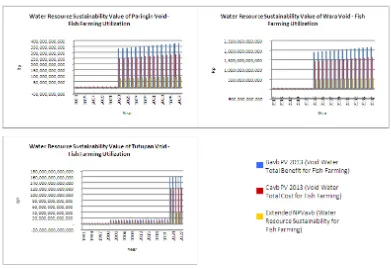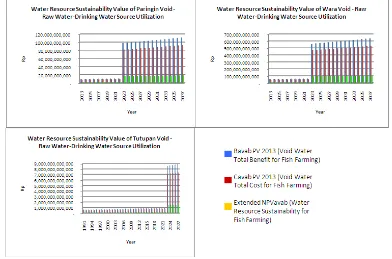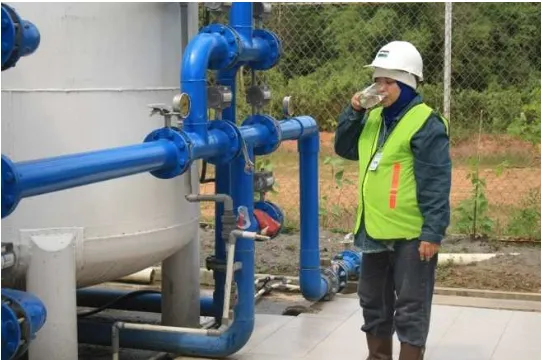International Journal of Applied Engineering Research ISSN 0973-4562 Volume 9, Number 9 (2014) pp. 1183-1199 © Research India Publications
http://www.ripublication.com
Model of Water Resources Sustainability: Mining Void
Water Utilization in Coal Mining (Case Study at PT. Adaro
Indonesia, South Borneo, Indonesia)
Setyo Sarwanto Moersidik1, Restu Juniah2, Setia Damayanti3, Yuni Reti Intarti4, Chaidir Arief5, Zoraya Rachmi Pratiwi6
Environmental Science, Postgraduate Programme & Environmental Engineering, Faculty of Engineering, University of Indonesia, Jakarta
1
ssarwanto@eng.ui.ac.id,
Environmental Science, Postgraduate Programme, University of Indonesia, Jakarta
2
restu_juniah@yahoo.co.id,
Environmental Science, Postgraduate Programme, University of Indonesia, Jakarta
3
bintangteddy@yahoo.com,
Relationship, Faculty of Social and Political Science, University of Indonesia, Depok
4
intarti@ui.ac.id, International
Postgraduate Programme, Faculty of Law, University of Indonesia, Depok
5
chaidir.arief@ui.ac.id.
Environmental Engineering, Faculty of Engineering, University of Indonesia, Jakarta
6
zoraya.rachmi@ui.ac.id
ABSTRACT
1184 Setyo Sarwanto Moersidik et al
includes drinking water, fish farming, and land farming. Calculations on the environmental services provided by mining void water for tourism, drinking water supply, and fish farming in PT. Adaro Indonesia shows an Extended NPV of Rp 7.124.884.062.739.430 (± USD 593, 740, 338, 561.62) and B/C ratio of 8, 25.
1. INTRODUCTION
Surface mining in coal mining causes void (ex-pit mining hole). This lead to ground water depletion because of opened soil layers causing loss of vegetation along with carrying capacity of water. Void caused by surface mining allowed storing of run-off water which gives potential environmental service in coal mining water sustainability. However, acid mine drainage (AMD) potential requires mining void water quality to be studied and assessed. As coal stockpile decreases along with post-mining, economic potential valuation of water and environmental service potential formed is necessary to assess mining sustainability. Sustainability concept roots to first thermodynamic principal and refer to natural system capacity to survive effectively through energy usage and waste generation minimalise entrophy (Jepson, 2001).
Conventional benefit and cost model in coal mining reckon fincancial cost benefit but not including mining void water environmental service cost benefit. For sustainability to be part of economic calculation and matter decision process, ecological and environment value need to be integrated into pricing policy in analysing the advisability of the activity (Djayadiningrat, 2000). Therefore a further approach of economic valuation from mining void water environmental service is needed. Conventional benefit cost (NPV) that calculates financial benefit and cost has been developed by Munangsih into extended NPV that reckon in external environmental cost benefit (Munasinghe, 1992). The purpose of this study is to find out the factors influencing raw water source sustainability from utilization of mining void water, benefit and cost component of mining void water environmental service value for various water utilization, and construct the model of extended benefit and cost related to water resource sustainability in coal mining.
2. METHODOLOGY / EXPERIMENTAL
This study is an exploratory research in which conducted by collecting datas on mining site in Kabupaten Balangan and Kabupaten Tabalong, South Borneo. Data collection is done by surveying, field observation, questionnaire distribution, and focus group discussion. Population and samples in this study are PT. Adaro Indonesia and the surrounding mining site community.
Model of Water Resources Sustainability: 1185
Table 1 Roots of Water Resource Sustainability Model
Extended model of benefit and cost of water resource sustainability in coal mining is designed based on the following steps:
1. Practice of benefit and cost analysis of sustainable coal mining should identify positive and negative externalities of coal mining impact towards mining void water environmental service value as raw water source during mining operation and post-mining.
2. Do an internalisation of external impact into benefit and cost model of water resource sustainability analysis by including financial and external community benefit and cost that arise because of the presence of mining void water environmental service as raw water source during mining, and benefit and cost of utilization of mining void water in post-mining.
3. Present value concept is used in calculating financial benefit and cost, environmental benefit and cost, community benefit and cost, and environmental service benefit and cost of mining void water as raw water source during coal mining and post-mining.
4. Net value calculation of coal mining environment sustainability, both benefit and cost flow, is done using present value concept.
1186 Setyo Sarwanto Moersidik et al
3. RESULT
Focus group discussion with public figures of surrounding mining site community, the community leaders, and housewives resulted in wishes of mining void water utilization as drinking water source and farming irrigration. Void water presence is necessary to community living around mining area such as farmers and planters. Social study toward Ring 1 Village (village located around mining area), PT. Adaro Indonesia, shows that mining void water can be utilized other than as raw water source, which are tourism and hydropower. Table 2 below shows the crosstab result from the distributed questionnaire.
Table 2 Crosstab Result from 80 Respondents
Wishes towards PT. Adaro Indonesia related to Mining Void Presence & Utilization
% Daily
water distri-bution
Proper life, Clean air and
water, good relationship
Fish-farming
Aid
Farming training, disease treatment,
planting spacing Main Job /
Profession
Farmer/planter 6 3 3 2 17.5
Employee of PT Adaro Indonesia
6 3 3 2 17.5
Enterpreneur 6 3 3 2 17.5
Civil worker 6 3 3 2 17.5
% 30 15 15 10 70
Model of Water Resource Sustainability of Mining Void Water Environmental Service Benefit and Cost in Coal Mining is constructed as the following,
CF = cash flow
Bd = direct benefit of mining void water utilization
Bid = indirect benefit of mining void water utilization
Cd = direct cost of mining void water utilization
Cid = indirect cost of mining void water utilization
Model of Water Resources Sustainability: 1187 Cav = total cost of mining void water utilization
Bav = direct benefit of mining void water
r = interest rate t = year 0 to T
∑ = sum
Table 3 Benefit and Cost of Mining Void Water Utilization of Existing Void on 3 Blocks (Paringin, Wara, Tutupan) in PT. Adaro Indonesia with and without Technology Intervention
No Void Water Utilization
Benefit Component Cost Component 1 Raw water
source
Technology intervention
(water treatment) Paringin Direct benefit Direct cost
Wara Direct benefit Direct cost Tutupan Direct benefit Direct cost 2 Tourism
Natural attenuation (no technology intervention) Paringin Direct
benefit Wara Direct
benefit Tutupan Direct
benefit
Natural attenuation (no technology intervention) Paringin Direct
benefit Wara Direct
benefit Tutupan Direct
benefit
118 tainability o onesia coal ended net p er as raw 437.090.559 622.543.356 185.452.796
ure 1 Grap ter Source a
ure 2 Graph urce at Tutup
Benefit and tourism in P
del of water of mining
phic of Ben at Tutupan,
hic of Bene pan, Wara,
r resource s void water
nefit and C Wara, and
efit and Cos and Paringi in Block, PT
ce sustainab oal mining Tutupan Void
ty, benefit a n as raw w sed is 1991
ustainability
bility of min with time
o Sarwanto M
and cost of water source – 2027. It y by utilizin
coal minin ock with tota
and total
rce Sustaina daro Indone
Void Water ndonesia
ning void w span used
f water reso e in PT A t is shown ng mining ng reaches
al benefit o cost of
Mod
del of Water
culation sho versity and a big potent ming. Base
r Resources
ows that ext ng void wate 824) at Tut 2, 473, 055,
3, 555).
phic of Bene ara, and Par
hic of Bene a, and Paring
s on freshw Limnology tial in deve ed on the
tended net p er as tourism tupan Block , 380) and t
efit and Co ringin Block
efit and Cos gin Block, P
water fish Research C lopment of calculation m reaches R k with total b
total cost of
st of Water k, PT. Adar
st Extended PT. Adaro I
and shrimp Center. Abu f fish resour
n using de
ue of water Rp 17.600.5 benefit of R f Rp 27.429
r Resource o Indonesia eveloped m n
r resource s 05.621.890 unt of water rvation and model of w
lity for Tou
r for Touris
119
tainability, b ization as f ended net 2.240.940.50
Rp 1.152.8 0.572.395.70
ure 5 Grap ming at Tut
ure 6 Grap ming at Tut
Interest rat t extended n .
benefit and fish farmin present 06.683 (± U 813.336.210
04.045 (± U
phic of Ben tupan, Wara
phic of Be tupan, Wara
e used in e net present
50,0 ng with tim value of USD 20, 18 0.730 (± U USD 75, 881
nefit and C a, and Parin
enefit and a, and Parin
ach calcula me span use
water re 6, 745, 042 USD 96, 06 1, 032, 975)
Cost of Wa ngin Block, P
Cost Exten ngin Block, P
ation of wat mining void Tutupan Void
‐Year 1991‐ 2) at Tutupa 67, 778, 01
Paringin ‐Y 2013‐203
g Void
o Sarwanto M
bility of min – 2027, it ustainability an Block w 18) and to
rce Sustaina Indonesia
e of Void W Indonesia
e sustainabi is 7% and i
Paringin Void
‐Year 2013‐
ning void w t is shown y reaches with total ben otal cost of
ability for
Model of Water Resources Sustainability: 1191
4. DISCUSSION
Tutupan void has the most beneficial environmental service cost because of its large mining area where it is the biggest site in PT Adaro Indonesia coal mining. Mining void water volume for each existing void in PT Adaro Indonesia can be seen on the Table 4 below.
Table 4 Total Volume of Mining Void Water at PT Adaro Indonesia Area Void Min. Elevation Max. Elevation Total Volume (m3)
Tutupan Hill 11 -20 119 40.615.641
T300 33 103 3.802.868
Wara Pit Slovenia 55 90 1.861.220
Paringin Ex-Pit PRG 30 87 5.434.305
pH level is the water quality key factor that allows its utilization. Reclamation action, including mining void water utilization, should be based on an increase in the pH and decrease the salinity (Martinez-Pagan, et al., 2011). Water utilization suggested based on social study are drinking water, fish farming, and land farming irrigation. Based on void years and natural pH stabilisation possibility, environmental service of mining void water according to time span of utilization from 5 year to 15 year after water filling sequentially are (1) tourism (2) fish farming (3) irrigation (4) hydropower and (5) drinking water source. The utilization as fish farming is a typical functions of ecological and socio-economical factor as in Central German lignite mining district (Schultze et al., 2009) while the major use of the pit lake (mining void) is for recreational purposes or tourism (Linke & Schiffer (2002) in Schultze et al., (2009)).
Calculating environmental benefit and cost of mining void water utilization reckon in that void formation in mining means groundwater depletion (relatively small amount) in mining area; run-off water will then fill mining void formed with relatively greater volume of water than groundwater depletion occured. Furthermore, mining void water formed has the possibility to be utilized directly despite acid condition with intervention of technology, as in this study at PT Adaro Indonesia.
1192 Setyo Sarwanto Moersidik et al
Mining void water is a subsided water in mining in which the water qualities are different with different time of subsidence, situation, and utilization (Liang-Ji et al.,
2007). The figure above shows that with natural attenuation, mining void can be utilized in the fifth year of its presence for tourism with an average extended net present value for three mining void area of Rp 7.036.802.170.523.070 (± USD 586, 400, 000, 000). Figure below shows the increasing benefit cost of mining void utilization for tourism based on calculation result of total benefit, total cost, and extended net present value of void for each void block.
Figure 8 Graphic of Total Benefit, Total Cost, and Extended NPV of Void Utilization for Tourism for Each Void Block at PT Adaro Indonesia
Model of Water Resources Sustainability: 1193 tourism sector such as water sport center, recreation center, and floating restaurant or
lake-view restaurant.
Figure 9 Exisiting Void in PT. Adaro Indonesia (Clockwise from Top-left: Hill 11 (Tutupan), T300 (Tutupan), Pit Slovenia (Wara), Ex-Pit PRG (Paringin))
1194 Setyo Sarwanto Moersidik et al
Figure 10 Graphic of Total Benefit, Total Cost, and Extended NPV of Void
Utilization for Fish Farming for Each Void Block at PT Adaro Indonesia
Beside freshwater fish farming, mining void water can also be utilized as irrigation water for plantations such as rubber that is the largest plantation existed in South Borneo beside palm oil. The use of mining void water as irrigation water will take use of great volume of water. Hence, the run off of water in mining area is an important issue for filling the mining void and stabilise the water balance for the sustainability of mining void utilization as an attemp of sustaining water resource in coal mining for the sustainability of the coal mining itself.
Model of Water Resources Sustainability: 1195 Mining void water can be utilized as raw water source for household needs and
drinking water in the 15th year of its presence with an average extended net present value for three mining void area of Rp 4.438.400.888.338 (± USD 369, 866, 740). The utilization as raw water source and drinking water resulted the least benefit because it has great cost on the water treatment plant. However, benefit from mining void water utilization as raw water and drinking water source can be obtained from the first year of mining void presence because of technology intervention that is water treatment plant. The price of raw water and water treatment by PAM Kabupaten Tabalong used in calculation are Rp 3.000, - and Rp 2.500, - respectively. Figure below shows the increasing benefit cost of mining void utilization for raw water source based on calculation result of total benefit, total cost, and extended net present value of void for each void block.
Figure 11 Graphic of Total Benefit, Total Cost, and Extended NPV of Void
Utilization for Raw Water-Drinking Water Source for Each Void Block at PT Adaro Indonesia
1196 Setyo Sarwanto Moersidik et al
Figure 12 Direct Utilization of Mining Void Water as Drinking Water with
Intervention of Technology
5. CONCLUSION
Based on social study in coal mining site and surroundings, mining void water utilization suggested are drinking water, fish farming, and land farming irrigation. According to void years and natural pH stabilisation possibility, environmental service of mining void water in accordance with time span of utilization from 5 year to 15 year after water filling sequentially are (1) tourism (2) fish farming (3) irrigation (4) hydropower and (5) drinking water source. However, the use of technology allows mining void water to be utilized as drinking water – raw water source in the first year of mining void presence. This study shows that mining void has beneficial value with calculations on void water environmental service as tourism, drinking-raw water source, and fish farming in PT. Adaro Indonesia shows Extended NPV of Rp 7.124.884.062.739.430 (± USD 593, 740, 338, 561.62) and B/C ratio of 8, 25. Extended NPV resulted greater than 0 (extended NPV > 0), which means water resource in coal mining, in this study is PT Adaro Indonesia coal mining, is sustainable. The model of water resource sustainability found is
References
Model of Water Resources Sustainability: 1197
[2] Alamsyah, D. (2013). Meningkatkan Pendapatan Masyarakat Merujuk Pada Usaha pembesaran Ikan Nila Di Kolam Pekarangan. Departemen Pertanian Republik Indonesia
[3] Abelson, P. (1980). Cost benefit analysis and environmental problem. Gower Publishing Company limited, westmeat, Faraboborough, Hampshire, England. ISBN: 0 566 00267i.
[4] Cass, R.S. (2000). Cognition and cost‐benefit analysis. The Journal of Legal Studies (vol. 29, pp. 1059-110. The University of Chicago Press
[5] Costanza, R., D'Arge, R., de Groot, R., Farber, S., Grasso, M., Hannon, B., Limburg, K., Naeem, S., O'Neill, R., Paruelo, J., Raskin, R., Sutton, P., & van den Belt, M. (1997). The Value of the World's Ecosystem Services and Natural Capital. Nature, 387(May): 253-260.
[6] Curtis, I.A. (2004). Valuing ecosystem good and services: a new approach usinga surrogate market and the combination of a multiple criteria analysis and a delphi panel to assign weight to attributs. EEcological Economics. pp. 163-194.
[7] Curtis, J., Salem Thawaba., J. Van Brahana, J. (2009). Constructed wetlands for the pre-treatment of drinking water obtained from coal mines. The Open Environmental Engineering Journal (vol. 2, pp.1-8). Ozark Hall, University of Arkansas, Fayetteville, AR, USA.
[8] Daily, G.C., & Polasky S. (2009). Ecosystem services in decision making: time to deliver. Frointiers in ecology 7(1), p.p. 21-28.
[9] De Groot. (2002). The dynamics and value of ecosytem services: inegrating economics and ecological persypectives a typology for the classification, description and valuation of ecosytem functions, good and services. Jurnal ecological economics (vol. 41, pp. 393-408).
[10] Djayadiningrat, S.T. (2001). Good governance, ekonomi dan ekologi. Jurnal Ekonomi Lingkungan (vol.12). Jakarta. ISSN: 0853-7194.
[11] Epstein, P. (2011). Details the economic, health and environmental costs associated with each stage in the life cycle of coal. In terms of human health. Virginia A February 2011.
[12] Fisher, B., & Turner, K. (2008). Ecosystem services: classification for valuation. Ecological Application. 141, pp. 1167-1169.
[13] Hardin, G. (1968). The tragedy of the commons. Science 162.
[14] Jepson, E. (2001), Sustainability and planning: diverse concepts and close associations. Journal of Planning. (Vol. 15 (4), pp. 499-510).
1198 Setyo Sarwanto Moersidik et al
[16] Juniah, R. (2011a). Dampak positif kegiatan pertambangan. In: Buku Panduan Valuasi Ekonomi Kegiatan Pertambangan. Jakarta: Kementerian Lingkungan Hidup Republik Indonesia,.
[17] Juniah, R. (2012b). Studi banding penelitian disertasi: pemanfaatan air limbah tambang untuk air minum di PT Adaro Indonesia Indonesia. Kabupaten Tabalong Provinsi Kalimantan Selatan.
[18] Liang-Ji, Xu., Jia-Ping, Yan., Gao Yong Mei, and Liu Yu-Ling. (2007). Study on Environmental Impact of Coal Mining Subsided Water Area in Huainan Mining Area. USA: Journal of Environmental Science and Engineering. December 2007 Vol. 1 No.1.
[19] Linke, S., Schiffer, L. (2002). Development Prospects for The Post-mining Landscape in Central Germany. In: Schultze, M., Pokrandt, Karl-Heinz, and Wofram Hille. (2009). Pit Lakes of The Central German Lignite Mining District: Creation, Morphometry, and Water Quality Aspects. Elsevire: Limnologica 40 (2010) 148-155.
[20] Mallet, C.W., & Mark, M.R. (1995). Review of the management and impact of mining voids, in Minerals Council of Australia 20th Annual Environmental Workshop ( pp. 260–275). Australia.
[21] Martinez-Pagan, P., Faz, A., Acosta, J.A., Carmona, D.M., Martinez-Martinez, S. (2011). A Multidisciplinary Study for Mining Landscape Reclamation: A Study Case on Two Tailing Ponds in The Region of Murcia (SE Spain). Elsevier: Physics and Chemistry of The Earth 36 (2011) 1331-1344.
[22] Miller, G.C., Lyons, W.B., Davis, A. (1996)). Understanding the water quality of pit lakes. Environmental Science and Technology / News (vol. 30 [3], pp.118–123).
[23] Moersidik, S.S. (2009). Pemanfaatan sumberdaya alam berkaidah kelestarian lingkungan. Paper di presentasikan pada Seminar Pengaruh Menyusutnya SDA Terhadap Potensi Konflik & Kemiskinan di Kalbar.
[24] Munasinghe, M. (1992). Environmental economics and valuation in development decision making. Environment Working (Paper No.51). Environment Department, Sector Policy and Research Staff. Washington: The World Bank
[25] Noviza Z Evy. (2007). Kajian Keberlanjutan Pasokan Air: Studi Kasus Kawasan Perumahan Kota Wisata, Kecamatan Gunug Putri, Kabupaten Bogor. Tesis Magister Program Studi Ilmu Lingkungan Universitas Indonesia, Jakarta. [26] Perusahaan Tambang Batubara PT Adaro Indonesia Indonesia. (2009).
Model of Water Resources Sustainability: 1199 [27] Perusahaan Tambang Batubara PT Bukit Asam. (2005-2009). Annual report
PTBA. http:/www.ptba.co.id. Accessed on Thursday, May 14th 2011: 10.33 West Indonesian Local Time.
[28] Rudeno Victor, (1998). The Mining Valuation Hand book. Australian Mining and Energy Valuation For Investor and Management. National Library of Australia Cataloguing in-Publication, ISBN: 1 875 857 81 8.
[29] Schultze, M., Pokrandt, Karl-Heinz, and Wofram Hille. (2009). Pit Lakes of The Central German Lignite Mining District: Creation, Morphometry, and Water Quality Aspects. Elsevire: Limnologica 40 (2010) 148-155.
[30] Slootweg, R., (2006). Biodiversity assessment Framework: making biodiversity of corporate social responsibility. Impact Assesment Project Apprasial.
[31] Soemarno, W.S. (2007). Perencanaan pembangunan pasca tambang untuk menunjang pembangunan berkelanjutan (studi kasus pada pertambangan batubara PT Kaltim Prima Coal di Kabupaten Kutai Timur, Provinsi Kalimantan Timur ). Disertasi. Jakarta: PSIL-UI.
[32] Suparmoko., M., Waluyo (2003). Natural Resourcing And Environmental Accounting). Proceeding Natural Resourcing And Environmental Accounting. Purwokerto 2003. BPFE- Yogyakarta, ISBN: 979-503-450-2.
[33] Turner, J.V., & Jones, D.R., (1998). Review of final void water quality in Australia. State of the art and development of a generic model. CSIRO Report 98-32, for Australian Centre for Mining Environmental Research.
